Important Note!
In Old School Pokémon, it is important to note that the first player to take a turn in a game may not make an attack, this is different from the original rules of the game, and is more in alignment with later rule sets. Please ensure you are following this step correctly.
What Do You Need to Play?
Well, you and your opponent will each need your own deck of 60 cards, a coin to flip, and some counters to mark damage to your Pokémon. You can use pennies or whatever else you want to if you run out of counters.
How to Win
In Pokémon, you can win three different ways. First, at the start of the game, you set aside 6 of your cards as Prizes. Every time one of your opponent's Pokémon is Knocked Out, you take 1 of your Prizes and put it into your hand. When you've taken all 6 of your Prizes, you win the game! (You'll win most of your games this way.) Second, you also win if your opponent doesn't have an Active Pokémon (or a Benched Pokémon to replace it with) at the end of any turn. And finally, you win if your opponent's deck is out of cards at the start of his or her turn.
Starting the Game
·Shuffle your deck and draw a starting hand of 7 cards. Put the rest of your deck face-down in front of you.
What If I Don't Have a Basic Pokémon Card in My Hand? Then show your hand to your opponent, shuffle it back into your deck, and draw 7 new cards. Your opponent can then choose to draw up to 1 extra card. If you still don't have any Basic Pokémon in your new hand, you repeat this process, but your opponent gets to draw up to 1 extra card each time! |
·You and your opponent each choose a Basic Pokémon card (it'll say "Basic Pokémon" in the upper left-hand corner) from your hands and put them face-down. These will be your starting Active Pokémon.
·Each player may, if he or she wishes, choose up to 5 Basic Pokémon from his or her hand and put them face-down on his or her Bench (this is where Pokémon wait when they're not the Active Pokémon).
·Put the top 6 cards of your deck face-down in front of you. These are your Prizes, which you take when your opponent's Pokémon are Knocked Out. You can't look at a Prize card until you take it.
·Flip a coin to decide who goes first. You can use your special Pokémon coin, if you have one.
·Flip over all the Active and Benched Pokémon that have been put on the table.
How Your Play Area Should Look
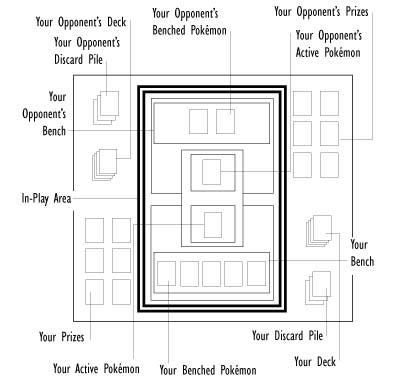
 Be sure to leave room for your discard pile. All of your cards that get discarded during the game, no matter how they get discarded, will go there.
Be sure to leave room for your discard pile. All of your cards that get discarded during the game, no matter how they get discarded, will go there.
 During the game, you'll be putting more and more cards on the table. All the cards on the table that are in the Active Pokémon area or on the Bench are referred to as being "in play." Your deck, your Prizes, and the cards in your discard pile are not considered to be "in play."
During the game, you'll be putting more and more cards on the table. All the cards on the table that are in the Active Pokémon area or on the Bench are referred to as being "in play." Your deck, your Prizes, and the cards in your discard pile are not considered to be "in play."
 Pokémon cards, Evolution cards, and Energy cards will be on the table-"in play"-after you play them from your hand. You can keep using those cards in play turn after turn. Trainer cards, though, are used once and then discarded.
Pokémon cards, Evolution cards, and Energy cards will be on the table-"in play"-after you play them from your hand. You can keep using those cards in play turn after turn. Trainer cards, though, are used once and then discarded.
Pokémon Card
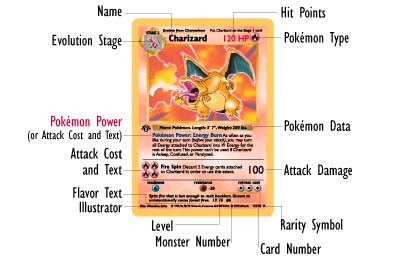
Trainer Card
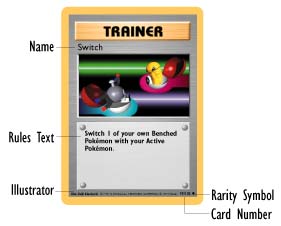
Energy Card
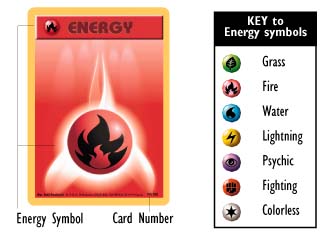
Let's Play!
As you play, you and your opponent take turns. During your opponent's turn, you don't do anything except replace your Active Pokémon if it gets Knocked Out (see below). During your turn, go through the steps below.
What Can You Do during Your Turn?
 You can do lots of things during your turn! You always draw a card first, and you always attack last. Here's everything you can do: You can do lots of things during your turn! You always draw a card first, and you always attack last. Here's everything you can do:
- DRAW a card
- DO ANY of the following in any order and as often as you like:
- Put a Basic Pokémon on the Bench
- Evolve a Pokémon in play
- Attach an Energy card to a Pokémon (only once per turn)
- Play a Trainer card
- Retreat your Active Pokémon
- Use a Pokémon Power
- ATTACK with your Active Pokémon (only after the first turn of the game)
- Your turn is OVER now
|
1) DRAW a card
You always begin your turn by drawing a card. (If your deck is empty at the beginning of your turn, the game is over, and your opponent wins.)
2) DO ANY of the following in any order and as often as you like:
Put a Basic Pokémon on the Bench
Choose a Basic Pokémon from your hand and put it face-up on your Bench. You can have no more than 5 Pokémon on your Bench at any time, so you can only put a new Basic Pokémon there only if your Bench has 4 or fewer Pokémon on it.
Evolve a Pokémon in play
If you have a card in your hand that says "Evolves from so-and-so" and so-and-so is the name of a Pokémon you already have in play, you may play that card in your hand on top of the Pokémon so-and-so. This is called "evolving" a Pokémon.
Example: Juliane has a card called Ninetales that says "Evolves from Vulpix," and she has a Vulpix card in play. She may play the Ninetales card on top of the Vulpix card.
When a Pokémon evolves, it keeps all cards attached to it (Energy cards, Evolution cards, etc.) and any damage it might already have, but the old attacks and Pokémon Powers of the Pokémon it evolved from go away. All other things about the Pokémon go away-Sleep, Confusion, Paralysis, Poison, or anything else that might be the result of an attack some Pokémon made earlier.
 Sorry, you can't evolve a Pokémon that you just played or evolved on that turn. Also, neither player can evolve a Pokémon on the first turn. And finally, yes, you can evolve a Pokémon on your Bench-that counts as "in play"!
Sorry, you can't evolve a Pokémon that you just played or evolved on that turn. Also, neither player can evolve a Pokémon on the first turn. And finally, yes, you can evolve a Pokémon on your Bench-that counts as "in play"!
Attach an Energy card to a Pokémon
Take an Energy card from your hand and attach it to one of your Pokémon in play (put it under the Pokémon card).
 Unlike most of the other things you can do during your turn, you may do this only once during your turn. Also, remember that you can attach an Energy card to a Pokémon on your Bench. After all, that's "in play," too!
Unlike most of the other things you can do during your turn, you may do this only once during your turn. Also, remember that you can attach an Energy card to a Pokémon on your Bench. After all, that's "in play," too!
Play a Trainer card
When you want to play a Trainer card, do what it says, then put it in the discard pile.
Retreat your Active Pokémon
You may switch your Active Pokémon with one of the Pokémon on your Bench. To do this, you must discard Energy attached to the Active Pokémon equal to the Retreat Cost that's written in the lower right-hand corner. (You'll read more about costs in the "Attack with Your Active Pokémon" section.) If you can't do that, then you can't retreat. Pokémon with no Retreat Cost don't need to get rid of any Energy when they retreat-they can retreat "for free."
A Pokémon that is Asleep or Paralyzed can't retreat. A Confused Pokémon can try to retreat, but it might not succeed. (Why this might happen will be explained later on in the rules.)
When your Active Pokémon goes to your Bench (whether it retreated or got there some other way), it keeps any Energy cards, any Evolution cards, and any damage counters it might already have. All other things about the Pokémon go away-Sleep, Confusion, Paralysis, Poison, or anything else that might be the result of an attack some Pokémon made earlier. All of these things go away.
If you retreat, you can still attack that turn with the new Active Pokémon.
Use a Pokémon Power
Some Pokémon have a special "Pokémon Power" that they can use when they're in play. (Remember, Benched Pokémon are "in play," too.) Many of these Powers can be used before you attack. Each Pokémon Power is different, though, so you should read carefully to see how each Power works.
 A Pokémon Power isn't the same as a Pokémon's attack, so if you use the Pokémon Power, you can still attack!
A Pokémon Power isn't the same as a Pokémon's attack, so if you use the Pokémon Power, you can still attack!
3) ATTACK with your Active Pokémon after the first turn of the game
If you wish, you may have your Active Pokémon attack your opponent's Active Pokémon (also called the "Defending Pokémon"). This is the last thing you can do during your turn-you can't do anything else afterward. You can only attack one time during your turn, and your Pokémon can only use one of its attacks each turn. To attack, just tell your opponent which one of your Pokémon's attacks you're using. You can only use an attack if you have at least the required amount of Energy attached to your Active Pokémon.
 The required amount is written to the left of the attack name.
The required amount is written to the left of the attack name.
·Energy
Any kind of Energy- ,
,  ,
,  ,
,  ,
,  ,
,  , or
, or  -can count toward Colorless Energy requirements (
-can count toward Colorless Energy requirements ( ). But only Energy of the appropriate kind counts toward Energy requirements of that kind. For example, you can use at attack with
). But only Energy of the appropriate kind counts toward Energy requirements of that kind. For example, you can use at attack with 

 next to it only if that Pokémon has at least 3 Energy attached to it, at least 2 of which are
next to it only if that Pokémon has at least 3 Energy attached to it, at least 2 of which are  Energy.
Energy.
 You have to have the required amount of Energy attached to a Pokémon to use its attack, but you don't have to discard those cards to attack. The cards stay attached to your Pokémon unless the card says otherwise!
You have to have the required amount of Energy attached to a Pokémon to use its attack, but you don't have to discard those cards to attack. The cards stay attached to your Pokémon unless the card says otherwise!
Damage
When you attack, read the attack you're using and do what it says. For each 10 damage a Pokémon takes, put one damage counter on it. If a Pokémon ever has total damage at least equal to its Hit Points (for example, 4 or more damage counters on a Pokémon with 40 HP), it's immediately Knocked Out.
Weakness and Resistance
Some Pokémon have a Weakness or Resistance to Pokémon of certain other types. (For example, Charmander has a Weakness to  Pokémon.) A Defending Pokémon takes double damage from a Pokémon that it has a Weakness to, and it takes 30 less damage from a Pokémon that it has Resistance to.
Pokémon.) A Defending Pokémon takes double damage from a Pokémon that it has a Weakness to, and it takes 30 less damage from a Pokémon that it has Resistance to.
 Usually the attack won't depend on the order you do this in, but if it does, then this is how you'll figure it out! First, you pay any costs (discarding Energy cards, for example) before seeing what the attack does. Then damage comes before any other effects. Also, Weakness is applied before other things that might change the amount of damage.
Usually the attack won't depend on the order you do this in, but if it does, then this is how you'll figure it out! First, you pay any costs (discarding Energy cards, for example) before seeing what the attack does. Then damage comes before any other effects. Also, Weakness is applied before other things that might change the amount of damage.
What happens when your Pokémon is Knocked Out?
Whenever one of your Pokémon is Knocked Out, put its Basic Pokémon card and all cards attached to it (Evolution cards, Energy cards, etc.) in your discard pile. Your opponent then chooses one of his or her Prizes (even if you Knocked Out your Pokémon yourself!) and puts it into his or her hand. After that, you must replace your Active Pokémon with a Pokémon from your Bench. (If you can't do this because your Bench is empty, you lose.) If your Active Pokémon and your opponent's Active Pokémon are Knocked Out at the same time, the player whose turn it is replaces his or her Pokémon last. The player whose turn it is chooses his or her Prize last as well.
4) Your turn is OVER now
Sometimes there are things to do after your turn is over but before your opponent's turn begins. After you've done those things, your opponent's turn begins.
What Happens after Each Player's Turn?
After each player's turn, if either player's Active Pokémon is Poisoned, it'll take damage, and if it's Asleep or Paralyzed it might recover. Then the next player's turn begins.
How Do Sleep, Confusion, Paralysis, and Poison Work?
Some attacks cause the Defending Pokémon to be Asleep, Confused, Paralyzed, or Poisoned. These things don't happen to a Benched Pokémon, only to an Active Pokémon-in fact, if a Pokémon goes to the Bench, these things are removed from it. And evolving a Pokémon also means it's no longer Asleep, Confused, Paralyzed, or Poisoned.
Asleep
If a Pokémon is Asleep, it can't attack or retreat. As soon as a Pokémon is Asleep, turn it sideways to show that it's Asleep. After each player's turn, flip a coin. On a heads, the Pokémon wakes up (turn the card back right-side up), but on a tails it's still Asleep, and you'll have to wait until after the next turn to try to wake it up again.
Confused
If a Pokémon is Confused, you have to flip a coin whenever you try to attack with it or whenever you try to make it retreat. Turn a Confused Pokémon with its head pointed toward you to show it's Confused.
When you try to make a Confused Pokémon retreat, you first have to pay the Retreat Cost by discarding Energy cards. Then flip a coin. On heads, you retreat the Pokémon as normal. On tails, the retreat fails, and that Pokémon can't try to retreat again that turn.
When you attack with a Confused Pokémon, you flip a coin. On heads, the attack works normally, but on tails your Pokémon attacks itself with an attack that does 20 damage. (If your Pokémon has a Weakness or Resistance to its own type, or if there's some other effect that would alter the attack, apply these things as usual.)
 On tails, the Active Pokémon does 20 damage to itself even if its attack normally doesn't do damage (like Squirtle's Withdraw attack).
On tails, the Active Pokémon does 20 damage to itself even if its attack normally doesn't do damage (like Squirtle's Withdraw attack).
Paralyzed
If a Pokémon is Paralyzed, it can't attack or retreat. Turn the Pokémon sideways to show it's Paralyzed. If an Active Pokémon is Paralyzed, it recovers after its player's next turn. Turn the card right-side up again.
 What this means is that if your Pokémon gets Paralyzed, it will be out of action on your next turn, and then it will be okay again.
What this means is that if your Pokémon gets Paralyzed, it will be out of action on your next turn, and then it will be okay again.
Card Positions
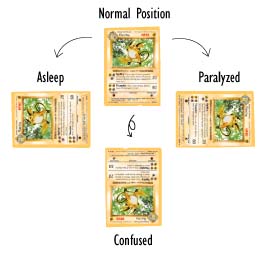
Poisoned
If a Pokémon is Poisoned, place a "poison marker" on it to show that it's Poisoned.
As long as it's still Poisoned, the Pokémon takes 10 damage after each player's turn, ignoring Weakness and Resistance. If an attack would Poison a Pokémon that's already Poisoned, it doesn't get doubly Poisoned; instead, the new Poison condition replaces the old one.
 Make sure whatever you use for a poison marker looks different from a damage counter.
Make sure whatever you use for a poison marker looks different from a damage counter.
Can Your Pokémon Be Asleep and Confused at the Same Time?
If a Pokémon is Asleep, Confused, or Paralyzed, and a new attack is made against it that causes it to become Asleep, Confused, or Paralyzed, the old condition is erased and only the new one counts. But these three conditions are the only attack effects that erase each other. For example, a Pokémon can be confused and Poisoned at the same time.
 STOP READING NOW! You know enough to start playing, so play a few games before you go on to the Expert Rules!
STOP READING NOW! You know enough to start playing, so play a few games before you go on to the Expert Rules!
Why Are There So Many Different Cards?
One of the things that makes Pokémon different from other card games is that it's a trading card game. This means that there are lots of different cards that you can collect and trade with your friends. Also, you aren't limited to just playing the decks you buy-you can use all the different cards you have to create totally new decks! A lot of the fun of a trading card game comes from making different decks that use different strategies.
How Do You Make a New Deck?
Your deck has to have exactly 60 cards, and you can't have more than 4 of any one card other than basic Energy cards in your deck (the basic Energy cards are  ,
, ,
, ,
, ,
, , and
, and ). A card counts as the same as another card if it has the same name-it doesn't matter whether the cards have different art or come from different sets.
). A card counts as the same as another card if it has the same name-it doesn't matter whether the cards have different art or come from different sets.
To make a new deck, first notice that all the cards other than the Trainers have different Energy types on them. Your deck should probably include one or two of the basic Energy types, and you can choose to add some Colorless ( ) Pokémon if you like. If you just choose one Energy type, you will always have the right kind of Energy for your Pokémon, but not as much variety. If you have several Energy types, you'll have more Pokémon to choose from, but you'll run the risk of sometimes not drawing the right type of Energy for your Pokémon. And be sure your deck has enough Energy cards (most decks need 25 to 30).
) Pokémon if you like. If you just choose one Energy type, you will always have the right kind of Energy for your Pokémon, but not as much variety. If you have several Energy types, you'll have more Pokémon to choose from, but you'll run the risk of sometimes not drawing the right type of Energy for your Pokémon. And be sure your deck has enough Energy cards (most decks need 25 to 30).
Once you've chosen your Energy types, pick Pokémon and Trainer cards that work well together. Do you want to build up big Pokémon to crush your opponent? Then put in a lot of Evolution cards and some Trainers like Pokédex that help you find those Evolution cards. Do you want to do a lot of damage to your opponent's Pokémon very quickly? Then pick Pokémon that don't need to be evolved and cards like PlusPower that do extra damage.
After you've made your deck, play it as often as you can against as many other decks as you can. See what works and what doesn't, and then make changes. If you keep working at it, you'll have a deck that will show everyone you're the greatest Pokémon Master of all time!


















